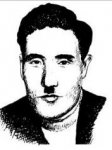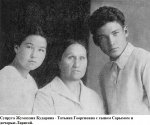 Many of us have heard about the street named after Zhumakhan Kuderin existing in the Southern Capital, but not everyone knows its exact location, as it is a continuation of Rozybakiev street from Raiymbek Avenue to Ryskulov Avenue and it has a length of only 1.5 km.
Many of us have heard about the street named after Zhumakhan Kuderin existing in the Southern Capital, but not everyone knows its exact location, as it is a continuation of Rozybakiev street from Raiymbek Avenue to Ryskulov Avenue and it has a length of only 1.5 km.
Kuderin Zhumakhan Mausumbayevich (1891(or 1893)-1938) is an educator, polymath, geographer, anthropologist and biologist.
Zhumakhan was born in Sredneayaguzskaya volost of Semirechye, in the family of ‘bai’ (rich landowner).The clan of Kuderin was an ancient and respected one in Semirechye (Seven Rivers). Cooderi (kүderі) is the name of area by the name of his grandfather Zhumakhan which means in Kazakh ‘suede, soft leather’.
The men of this clan had been literate for several generations, had been elected ‘biys’, i.e. judges of the family union. Zhumakhan did not have to follow in the footsteps of his older relatives. Owing to jute, the family went bankrupt, and a boy of ten turned to the labourers. Later,he studied at a Muslim school in Sergiopol town, at a private school ‘Mamania’ built in the likeness of Ufamadrasah ‘Galia’ located in Koksu agricultural school.
He had been a member of the Russian Communist Party of Bolsheviks since 1918 and had worked in various land agencies.He left the party in protest against the unjustified repressions exercised by ‘the Cheka’ to the participants of so-called ‘Cherkasy Defence’, that is the residents of 13 resettlement villages of Semirechye who resisted Kolchak’s troops in 1920.
He studied at the Faculty of Agriculture at SAGU in 1924-30s and at the same time taught at the courses, literacy classes, participated in three research expeditions aimed at studying natural resources and zoning of Turkestan. Kuderin worked in the Commission ‘On the return of Kazakhs from China’, and 6,000 families returned to their homeland through his kind offices. He took part in an expedition around Turkestan region. He served as Commissioner of the land of KazASSR in 1928. J. Kuderin wrote 44 books within his 44 years. He is the author of the ‘ABC’ textbook in the Kazakh language (1919), a series of books on natural sciences (incl. Vol. of ‘Botany’ in the Kazakh language rendered in Arabic script), published ethnographic works about Kazakhs (‘Kytaydagy boskyndar omіrі’, Kazaktardyn ata-tegi turaly Materialdary‘) and Biological Research (‘Kendіr’, ‘Koy men onyn zhuni’, ‘Kant kyzylshasy’, ‘Orta Aziadagy zhylandar turi’).
Kuderin accomplished many deeds as a biologist. He bred a kind of ambisexual hemp in 1930. Then it was cultivated for fiber and oil. But he did not benefit from the work results, as he was arrested, and manuscripts were confiscated. He could publish the results only in parts.
Zhumakhan Kuderin was arrested on the charge of nationalism on September 1, 1930, at the agricultural base near Tashkent city, where he conducted experiments after graduation from the Central Asian State University. Six months before this his father was arrested and all the men of their clanas well (and later on his brothers escaped and went to Xinjiang). Kuderin was convoyed to the investigation to Alma-Ata, where he was imprisoned in one-man cell and was accused of ‘bourgeois nationalism’ along with other educated Kazakh scientists and philosophers of the first generation. The investigation was being conducted for two years. The suspects were in one-man cell all the time.
The guilt in the actions of ‘bourgeois nationalists’was not proven and the case was forwarded to Moscow, where they found no hard evidences as well. It was proposed to disband all the people totheir home, but the Plenipotentiary Representative of the OGPU in Kazakhstan stated that all persons on remand might compromise the OGPU by describing this arbitrary actions. He suggested banishing all the people into exile in Russia, in order to conceal this fact. Kuderin was sentenced to 5 years in April 1932. Central Black Earth region was selected as an administrative exile place. Zhumakhan started to discharge the exile in Lgov, but later, due to his illness, was transferred under the supervision of doctors to Voronezh city, and the exile time was reduced by 1 year. Zhumakhan Kuderin worked as an agronomist within his staying in exile.
He and his family returned to Alma-Ata city, where he started as a senior scientific researcher of the Kazakh Research Institute of livestock breeding in 1935. However, he was dismissed as the one having a criminal record in 1936. Kuderin met and made friends with the Russian poet, novelist, literary critic and journalist Yuri Dombrowski within this period, and until his new arrest, had been actively working on the Russian-Kazakh-Latin dictionary.
Secondly, Kuderin was arrested on May 21, 1937 and again was imprisoned. He was arrested as ‘the head of the anti-Soviet nationalist, terrorist-insurgent, sabotage and spy organization’.His personal case was filed. The investigation was carried out by the criminal investigator of UGB NKVD of Alma-Ata region – VY Yakupov, ‘The Angel of Death’, as he was called by his prisoners. The point was, that all the cases that he was engaged in, were given a death sentence. Zhumakhan Kuderin was convicted on March 7, 1938, was sentenced to capital punishment and shot dead on the same day.
Zhumakhan Kuderin was post humously rehabilitated for both arrests in1958 and in 1990.
 Kuderin’s daughter, Larissa Zhumakhanovna Kuderina (born in 1938) opened a museum ‘Children to their Parents’dedicated to the repressed scientists in Moscow in Podsosensky alley in the basement of an old apartment building. A small display includes photographs, documents, books and pictures.
Kuderin’s daughter, Larissa Zhumakhanovna Kuderina (born in 1938) opened a museum ‘Children to their Parents’dedicated to the repressed scientists in Moscow in Podsosensky alley in the basement of an old apartment building. A small display includes photographs, documents, books and pictures.
Adapted from the website http://semeylib.kz/?page_id=2880&lang=ru.